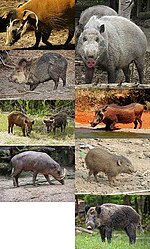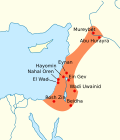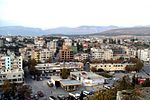 | The Anatolian boar (Sus scrofa libycus) is a subspecies of wild boar endemic to Turkey, Levant, Israel and Transcaucasia. It is likely to be one of the... 1 KB (52 words) - 22:12, 23 September 2022 |
Andersson, Leif; Cooper, Alan (2005). "Worldwide Phylogeography of Wild Boar Reveals Multiple Centers of Pig Domestication". Science. 307 (5715): 1618–21... 167 KB (5,337 words) - 21:39, 26 April 2024 |
 | The Eastern Anatolian deciduous forests ecoregion is located in the mountains of eastern Turkey. It is a Palearctic ecoregion in the temperate broadleaf... 6 KB (506 words) - 15:01, 4 August 2023 |
 | Panthera pardus tulliana (redirect from Anatolian leopard) Panthera pardus tulliana, also called Anatolian leopard, Persian leopard and Caucasian leopard in different parts of its range, is a leopard subspecies... 73 KB (7,800 words) - 16:15, 28 April 2024 |
The Museum of Anatolian Civilizations (Turkish: Anadolu Medeniyetleri Müzesi) is located on the south side of Ankara Castle in the Atpazarı area in Ankara... 19 KB (2,355 words) - 04:36, 24 April 2024 |
 | Africa, South America, and Southeast Asia, with the exception of the wild boar, which is additionally native to Europe and Asia and introduced to North... 37 KB (1,576 words) - 00:15, 12 January 2024 |
 | called boar taint, is caused by androstenone and skatole concentrations stored in the fat tissues of the animal after sexual maturity. Boar taint is... 81 KB (9,248 words) - 18:39, 27 April 2024 |
 | Asiatic lion (redirect from Anatolian lion) night, showing a high temporal overlap with sambar (Rusa unicolor), wild boar (Sus scrofa) and nilgai (Boselaphus tragocamelus). In general, lions prefer... 86 KB (8,823 words) - 07:52, 18 April 2024 |
 | Cybele (category Hellenistic Anatolian deities) Lydian Kuvava; Greek: Κυβέλη Kybele, Κυβήβη Kybebe, Κύβελις Kybelis) is an Anatolian mother goddess; she may have a possible forerunner in the earliest neolithic... 77 KB (10,339 words) - 04:33, 24 April 2024 |
Hecate (category Anatolian deities) cult site in Lagina. While many researchers favour the idea that she has Anatolian origins, it has been argued that "Hecate must have been a Greek goddess... 100 KB (12,111 words) - 16:55, 28 April 2024 |
 | run parallel to the Eastern Mediterranean coast, are in the Southern Anatolian montane conifer and deciduous forests ecoregion. Several large cities... 8 KB (774 words) - 01:21, 27 February 2024 |
Capital: Merv[citation needed] Kerman Seljuk Sultanate Sultanate of Rum (or Anatolian Seljuks). Capital: Iznik (Nicaea), later Konya (Iconium) Salghurids in... 169 KB (17,283 words) - 23:53, 14 April 2024 |
 | famous tombs in Lycia. The sarcophagus can probably be attributed to an Anatolian dynast of Hellespontine Phrygia. The longer face of the sarcophagus is... 7 KB (619 words) - 23:21, 21 August 2023 |
corresponding Latin cognate exists. Similarly, a cognate from another Anatolian language (e.g. Luvian, Lycian) may occasionally be given in place of or... 337 KB (8,973 words) - 03:56, 2 May 2024 |
 | that she belonged to Haplogroup X. She is phenotypically similar to the Anatolian early farmers and Caucasus Hunter-Gatherers. Her DNA revealed that she... 17 KB (1,141 words) - 10:53, 27 March 2024 |
 | century BC, Mycenaean power started expanding towards the Aegean, the Anatolian coast and Cyprus. Mycenaean armies shared several common features with... 22 KB (2,662 words) - 22:43, 4 April 2024 |














